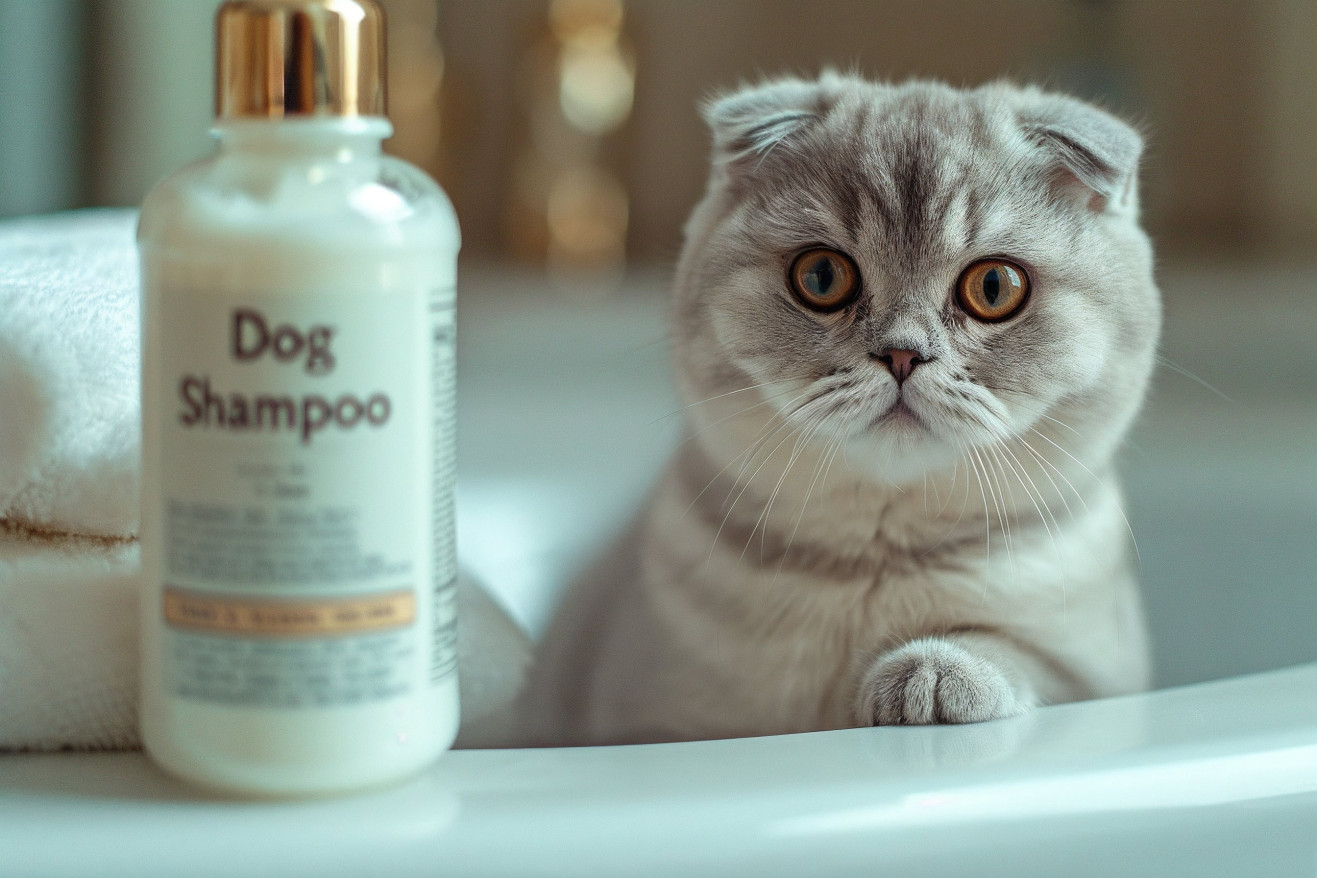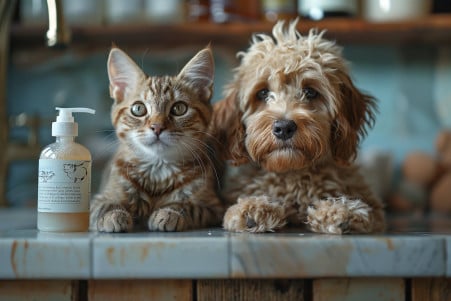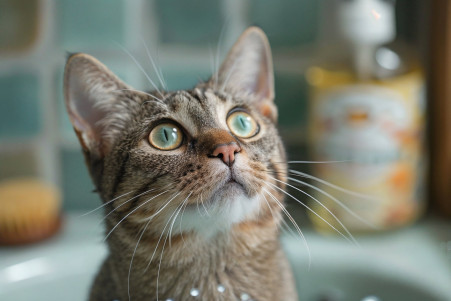Can You Use Dog Shampoo on Cats? Understanding Pet Grooming Safety
8 February 2024 • Updated 7 February 2024

If you’re a cat owner, you’ve probably found yourself in the pet aisle wondering if the dog shampoo is a viable option. However, it is not safe to use dog shampoo on cats because of differences in pH and potentially toxic ingredients. To protect your cat’s skin and prevent adverse reactions, it’s important to always use a cat-specific shampoo since cats have more sensitive skin than dogs.
We’ll take a deep dive into veterinary research and expert advice to better understand the ins and outs of feline dermatology, including the much higher pH of cats compared to dogs and how that impacts the safety of pet products.
We’ll also look at the ingredients in pet shampoos that are especially dangerous to cats so you can better understand the potential health risks and the best ways to meet your cat’s grooming needs.
Can you use dog shampoo on cats?
Why Skin pH Is Important for Pets
The pH of the skin is a critical factor in the overall health and well-being of pets, as it is the first line of defense against bacteria, viruses, and fungi. The pH scale ranges from 1 to 14 and measures how acidic or alkaline a substance is, with 7 being neutral. While the pH of human skin is around 5.5, the pH of pet skin varies, which is why it’s important to use grooming products that are species-specific.
The pH of dog skin is closer to neutral, ranging from 6.2 to 7.4, while the pH of cat skin is more acidic, ranging from 5.5 to 7.0 according to DERMagic. While this difference may seem small, it’s important when it comes to choosing grooming products. For example, if a dog shampoo is used on a cat, it can disrupt the cat’s skin pH, which can lead to dryness, irritation, and even infection.
This is why it’s important to use grooming products that are pH-balanced and formulated specifically for pets. For example, DERMagic’s Feline Organic Shampoo Bar is formulated to meet the specific pH needs of cats, which helps to maintain the skin barrier.
Always make sure to use grooming products that are labeled as formulated for dogs or cats, and avoid products that are labeled as pet-friendly, as they may not take these important differences into account.
The Risks of Using Dog Shampoo on Cats
Not all pet products are made the same, and using dog shampoo on cats can be dangerous. For example, Permethrin, an ingredient in dog flea treatments and shampoos, is extremely toxic to cats. According to PRIDE+GROOM, even a small amount of Permethrin can cause serious health problems or even death in cats.
If you use a product that contains Permethrin on a dog, you should make sure that the dog stays away from cats to avoid accidental exposure.
In addition to being more sensitive to certain ingredients, cats also have more acidic skin than dogs. The pH of a cat’s skin is about 6, while the pH of a dog’s skin is about 7.5.
Using a product with the wrong pH on a cat can lead to the cat’s skin being stripped of its natural oils, which can cause skin irritation and other skin issues.
PRIDE+GROOM explains that some ingredients, such as certain essential oils and coal tar, which can be beneficial for a dog’s skin, are not suitable for cats and can interfere with their ability to self-groom, which can lead to increased stress and dirtiness.
If a cat is accidentally exposed to dog shampoo, it’s important to act quickly. Bathe the cat with a cat-safe shampoo to help reduce the risk of skin irritation or toxicity. After exposure, it’s important to watch for signs of a reaction, such as skin redness or irritation, as well as other signs of toxicity, such as lethargy or difficulty breathing.
What to Do If Your Cat Is Exposed to Toxic Shampoo
It is important to know the signs of pyrethrin/pyrethroid poisoning in cats so that you can act quickly if you notice any of them. VCA Animal Hospitals lists clinical signs of poisoning in cats, which include drooling, hyperexcitability, vomiting, tremors, seizures, and difficulty breathing. If you think your cat has been exposed to dog shampoo that contains pyrethrin or pyrethroids, it is important to get them to the vet right away.
Veterinarians will start by decontaminating the cat to prevent further exposure to the toxins. VCA Animal Hospitals says that this will involve bathing the cat with liquid dish soap to remove the residue.
If the cat is showing signs of neurologic toxicity, they may need to be hospitalized for supportive care, which can include IV fluids, seizure control, and maintaining normal body temperature. Since there is no specific antidote for pyrethrin/pyrethroid poisoning, supportive care is the most important part of treatment.
A study published in PMC reports that intravenous lipid emulsion therapy was used to successfully treat a cat with permethrin toxicosis, with the cat showing marked improvement within hours. This treatment option is a good example of how a cat can have a positive outcome if they receive prompt and appropriate treatment.
Knowing this, it is clear that the best way to keep our cats safe is to prevent exposure and to be informed about how to safely bathe and groom our pets.
The Science of Self-Cleaning: Why Do Cats Groom Themselves?
Cats are known for being clean animals, and for good reason. According to The Spruce Pets, most cats spend between 30 and 50 percent of their waking hours grooming themselves. This self-cleaning ritual is important for a cat’s health and well-being.
When a cat grooms, it causes the skin to produce sebum, an oily substance that helps lubricate the fur, making it shiny and creating a protective barrier. Grooming also helps remove loose fur, preventing matting, and dirt and parasites are removed when a cat licks its fur.
However, self-grooming is more than just a cleanliness routine. It’s also a way for a cat to monitor its health. If a cat changes its grooming habits, it could be a sign that it’s in pain or sick.
In addition, since cats don’t sweat, they rely on the evaporation of saliva during grooming to help keep cool. If a cat is panting, it’s a sign that it’s too hot and is not able to cool itself down properly.
This natural balance can be disrupted by using grooming products like dog shampoo, which is not pH balanced for a cat’s skin and can contain harsh chemicals that can strip away the sebum, leaving the skin exposed and disrupting the cat’s grooming routine.
This can lead to skin problems and stress, as grooming is both a comfort and a necessity for cats. This is why it’s so important to use grooming products that are formulated for a cat’s skin and coat.
Safety of Pet Grooming Products
Rigorous research and regulatory standards ensure the safety and effectiveness of pet grooming products, including shampoos. To protect the health of animals, it is important that manufacturers test these products thoroughly to make sure they meet the necessary requirements. An article by Situ Biosciences emphasizes the importance of a thorough testing process that includes microbial contamination control, preservation efficacy, and environmental impact assessments.
Regulatory agencies, as outlined in the Pet Product Regulations guide, are important for setting safety standards and labeling guidelines for pet products. This makes sure that the ingredients and potential risks are clear to consumers, which in turn protects the health of different animal species. For example, the Federal Food, Drug, and Cosmetic Act, as noted by MSPCA-Angell, mandates that personal care products, including pet shampoos, are safe for use before they are sold.
It is important to make sure that product formulations are different, especially when comparing dog and cat shampoos. Manufacturers create these products with the pH balance and skin sensitivity of each animal in mind. By taking these differences into account, the industry is upholding the highest safety standards and making sure that grooming products are meeting the physiological needs of animals and supporting their health and wellness.
Other Ways to Groom Your Cat
If you’re worried about the risks of using dog shampoo, there are other ways to keep your cat clean. Vets suggest using safe options like grooming wipes, foam cleansers, and waterless shampoos, which are listed by PetMD, that are made for cats and can be a good option for cats who don’t like water.
In addition, natural grooming tools like fine-toothed flea combs and soft brushes can help remove dirt and loose fur, keeping your cat’s coat healthy.
Not only does regular brushing help keep your cat clean and reduce hairballs, but it can also be a bonding experience for you and your pet. The American Society for the Prevention of Cruelty to Animals (ASPCA) explains that regular brushing can also help mimic the natural grooming behavior that cats do themselves.
When you need to give your cat a bath, make sure to use a cat-specific shampoo that is gentle and pH-balanced for their skin. According to the Cornell University College of Veterinary Medicine, these gentle shampoos should be used in combination with regular brushing to make sure your cat’s hygiene needs are met.
By making sure you use these safe, appropriate methods, you can be sure your cat is clean and comfortable without using dog shampoo.
Final Thoughts on Feline Grooming Safety
In summary, our pets’ health is heavily impacted by how we choose to groom them. Using dog shampoo on cats is a prime example of how our grooming choices can put our pets at risk, as cat skin pH is different and more sensitive than dog skin.
The dangers of exposing cats to the toxic ingredients found in dog grooming products, like Permethrin, are very real and can lead to serious health issues, which is why it’s so important to use species-specific products.
This article has emphasized the importance of understanding pet grooming safety and skin pH science, as well as the importance of knowing what to do if you suspect your pet has been exposed to toxic substances and the benefits of sticking to natural cat grooming behaviors. We’ve also looked at the role of regulatory agencies in protecting pets from unsafe grooming products and explored grooming options that respect cats’ sensitive skin.
As we continue to be responsible pet owners, it’s important that we make informed decisions about how we care for our pets’ hygiene. Choosing grooming products that are made specifically for cats is not only a way to protect their health and well-being but also a way to show that we care about them. Let’s make choices that support the safety and happiness of our feline friends.


